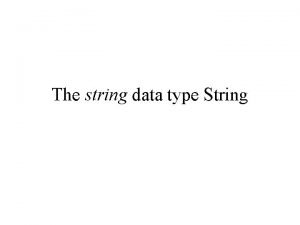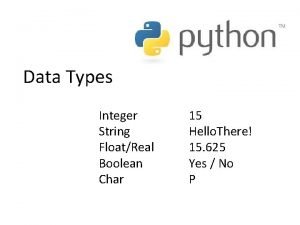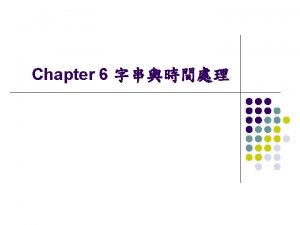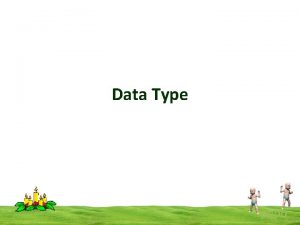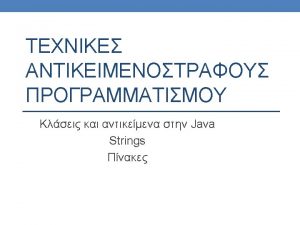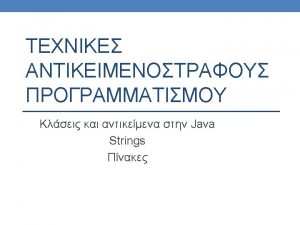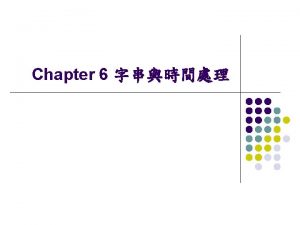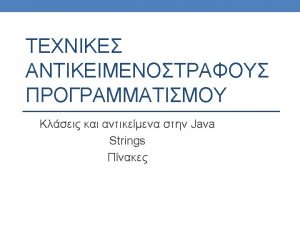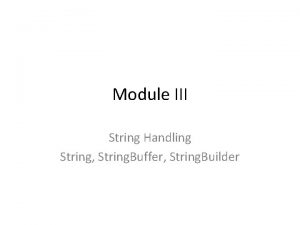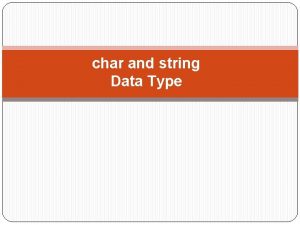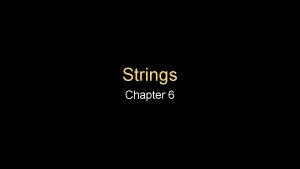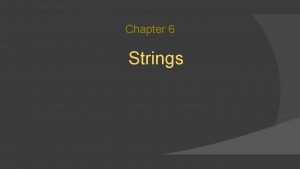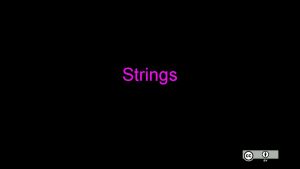The string data type String String 1 The






















- Slides: 22

The string data type String

String (1) • The String data type is the first data type that we learn that is not built-in into the programming language The String data type is a class that is constructed using the char data type: 1. The information of the String data type is stored using a number of char typed variables 2. The operations on String data are implemented by a number of methods (= computer programs)

String (2) • A string is a sequence of characters enclosed between the double quotes ". . . “ • Each character in a string is of the type char and uses the Unicode as encoding method

String literals (1) • We write string literals between double quotes ". . . “ • Escape character = a special character that allow Java to change the meaning of the next character • (backslash) = the escape character for strings

String literals (2) • Escape sequence = the escape character followed by one character • The character denoted by an escape sequence is usually one that you cannot type in with the keyboard

Defining String typed variables (1) • Syntax to define a String typed variable: • The class String announces the variable definition clause • The Name. Of. Variable is an identifier which is the name of the variable. • The variable definition clause is must be ended with a semi-colon "; " • A String typed variable can store the location (address) of a sequence characters (string)

Defining String typed variables (2)

How strings are stored inside the computer (1) • Challenge: Strings have variable lengths, • So you cannot store a string in a fixed sized variable. • There are 2 techniques in Computer Science for storing strings: 1. The location + length method 2. The location + sentinel method

How strings are stored inside the computer (2) 1. The location + length method: • The characters of string is stored (using Unicode encoding) somewhere consecutively inside the RAM memory • A string variable contains: the location of the first character of the string the length of the string (total number of characters in the string)

How strings are stored inside the computer (3)

How strings are stored inside the computer (4) • 2. The location + sentinel method: • Sentinel = a special character that denotes the end of a string. (usually the NULL character with Unicode value 0. ) • The sentinel is added after the last character of the string • A string variable contains: the location of the first character of the string

How strings are stored inside the computer (5)

How strings are stored inside the computer (6) • The location + length method is much more efficient • Java uses the location + length method to store String typed data • Obtaining the length information of strings in Java: Let a be a String typed variable. The expression a. length() returns the length of the string stored in the string variable a.

How strings are stored inside the computer (7)

numbers and numeric strings • Numeric string uses the Unicode encoding method ! • They use different representation (encoding) techniques)

Converting integer and floating point values to strings (2) • int <=> String: • double <=> String: • Float <=> String:

Converting integer and floating point values to strings (3)

Operators on the String data type (1) • Only one operator (the + operator) defined for the String data type: string 1 + string 2 = concatenate the strings string 1 and string 2

The + operator on number typed and String typed data (1) • Java provides an automatic conversion feature when the + operator is used between: a number typed data and a string typed data • The number is automatically converted to a string • The + operator is then applied on 2 strings (i. e. , the + operator is a concatenation !)

The + operator on number typed and String typed data (2)

Reading a string from the keyboard

Other operations on Strings 1. char. At(i): return the character at position i in the string. 2. substring(i, j): return the substring consisting of the characters between positions i and j-1 in the string.
 Http protocol description
Http protocol description String data example
String data example String data type
String data type String data type
String data type Const name void
Const name void Public class person private name
Public class person private name Str string
Str string String work is a type of garnish used with
String work is a type of garnish used with Hình ảnh bộ gõ cơ thể búng tay
Hình ảnh bộ gõ cơ thể búng tay Slidetodoc
Slidetodoc Bổ thể
Bổ thể Tỉ lệ cơ thể trẻ em
Tỉ lệ cơ thể trẻ em Gấu đi như thế nào
Gấu đi như thế nào Chụp tư thế worms-breton
Chụp tư thế worms-breton Hát lên người ơi
Hát lên người ơi Môn thể thao bắt đầu bằng từ chạy
Môn thể thao bắt đầu bằng từ chạy Thế nào là hệ số cao nhất
Thế nào là hệ số cao nhất Các châu lục và đại dương trên thế giới
Các châu lục và đại dương trên thế giới Công thức tính độ biến thiên đông lượng
Công thức tính độ biến thiên đông lượng Trời xanh đây là của chúng ta thể thơ
Trời xanh đây là của chúng ta thể thơ Mật thư anh em như thể tay chân
Mật thư anh em như thể tay chân Phép trừ bù
Phép trừ bù Phản ứng thế ankan
Phản ứng thế ankan

